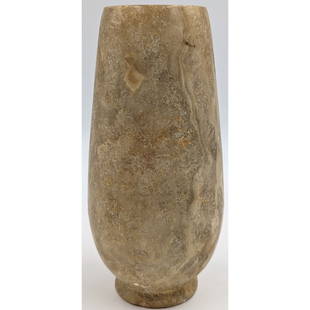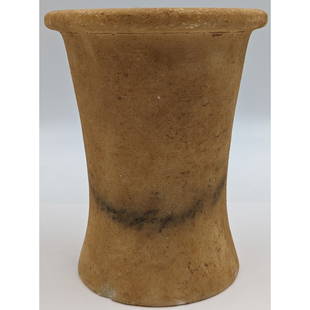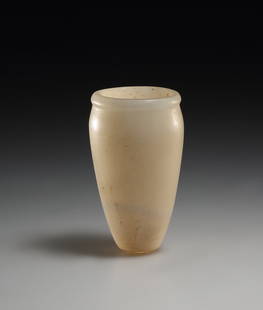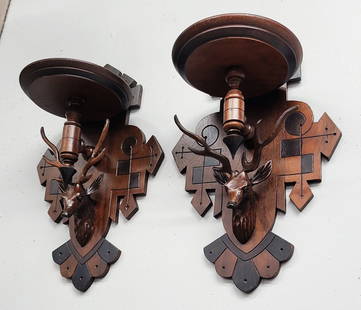
Egyptian Alabaster Canopic Jar of Hapy, Baboon Head
Similar Sale History
View More Items in Home & Décor

Related Home & Décor
More Items in Ancient Egyptian Home & Décor
View More






Item Details
Description
Egypt, Late Dynastic Period, 26th to 31st Dynasty, ca. 664 to 332 BCE. A gorgeous canopic jar, hand-carved from banded alabaster to boast a baboon-head lid representing the god Hapy, one of the 4 sons of Horus who was depicted in funerary literature as protecting the throne of Osiris in the Underworld. Minimalist in form, the simian head displays an elongated snout with a prominent brow ridge and recessed eyes, flanked by a lobed mane. The lid covers a deep interior cavity meant to contain and protect the mummy's internal organs, which were removed during the mummification process. Each canopic jar was fashioned to look like one of the Four Sons of Horus and tasked with protecting a different internal organ. Canopic jars of Hapy, like this example, were charged with preserving the lungs of the deceased and were safeguarded by the goddess Nephthys. Skillfully carved, this vessel's naturally banded alabaster presents hues of cream, honeycomb, and peach that beautifully highlight the vessel's elegant form and smooth surface. Size: 5.5" Diameter x 10.8" H (14 cm x 27.4 cm)
Canopic jars are some of the most iconic artifacts from Egypt, made to hold internal organs removed during the mummification process. This tradition lasted for an incredibly long time - the first evidence for a canopic chest containing organs comes from the Fourth Dynasty (ca. 2600 BCE) and they were used into the late 1st millennium BCE. The 18th Dynasty marked a shift in canopic jar tradition, when these jars were given to all people of status, and when their heads were fashioned to look like the four Sons of Horus, including Hapy as seen here. The Four Sons were charged with protecting the internal organs, as they had originally been charged with protecting the body of Osiris. The baboon-headed son who represented the north, Hapy, was charged with protecting the lungs of the deceased and was protected by the goddess Nephthys.
A stylistically similar example, of a slightly taller size and with a frontal inscription, hammered for $21,250 at Sotheby's, New York "Antiquities" auction (June 8, 2011, lot 94).
Cf. Smithsonian National Museum of Natural History, 138216 and Metropolitan Museum of Art, 10.178.1a, b.
Provenance: private New York, New York, USA collection; ex-Faith Dorian and Marin Wright collection, New York, USA, acquired between the 1960s - 1970s
All items legal to buy/sell under U.S. Statute covering cultural patrimony Code 2600, CHAPTER 14, and are guaranteed to be as described or your money back.
A Certificate of Authenticity will accompany all winning bids.
We ship worldwide to most countries and handle all shipping in-house for your convenience.
#175450
Canopic jars are some of the most iconic artifacts from Egypt, made to hold internal organs removed during the mummification process. This tradition lasted for an incredibly long time - the first evidence for a canopic chest containing organs comes from the Fourth Dynasty (ca. 2600 BCE) and they were used into the late 1st millennium BCE. The 18th Dynasty marked a shift in canopic jar tradition, when these jars were given to all people of status, and when their heads were fashioned to look like the four Sons of Horus, including Hapy as seen here. The Four Sons were charged with protecting the internal organs, as they had originally been charged with protecting the body of Osiris. The baboon-headed son who represented the north, Hapy, was charged with protecting the lungs of the deceased and was protected by the goddess Nephthys.
A stylistically similar example, of a slightly taller size and with a frontal inscription, hammered for $21,250 at Sotheby's, New York "Antiquities" auction (June 8, 2011, lot 94).
Cf. Smithsonian National Museum of Natural History, 138216 and Metropolitan Museum of Art, 10.178.1a, b.
Provenance: private New York, New York, USA collection; ex-Faith Dorian and Marin Wright collection, New York, USA, acquired between the 1960s - 1970s
All items legal to buy/sell under U.S. Statute covering cultural patrimony Code 2600, CHAPTER 14, and are guaranteed to be as described or your money back.
A Certificate of Authenticity will accompany all winning bids.
We ship worldwide to most countries and handle all shipping in-house for your convenience.
#175450
Condition
Expected surface wear with some natural pressure fissures to stone and nicks and abrasions, all commensurate with age. Wear to base causes it to sit on a slight wobble, but still stable overall and in choice condition.
Buyer's Premium
- 26.5%
Egyptian Alabaster Canopic Jar of Hapy, Baboon Head
Estimate $14,000 - $21,000
12 bidders are watching this item.
Shipping & Pickup Options
Item located in Louisville, CO, usSee Policy for Shipping
Payment

TOP













































